
One of my long term goals is to put together a selection of period or period-style tools. One of the simplest and easiest to make is a shovel. I needed to get the shovel together quickly, so this project was done with a less exacting standards of research and craftsmanship than usual.
There is a small number of surviving shovels from the medieval period and fewer that I have been able to find good information on. Typical of this is a shovel found at the excavation of Vadum Jacob, Israel. This dig is the site of a battle fought in 1179 between the Kingdom of Jerusalem and Ayyubid Caliphate contesting a castle which was in the process of being built. “A remarkable collection of iron tools has been recovered from the excavations at Vadum Jacob. These include spades, axes, picks, hoes, chisels, and spatulas” (Boas 1999) The proximity of the Vadum Jacob finds to my target year of 1189 and physical proximity to my area of interest makes those finds ideal sources of information. Unfortunately the only information about these tools I have found so far is in the quoted work, and is limited to a paragraph and few sketches without a scale.(Figure 1)
Because the lack of either the lack of published information or my inability to find it, and the quick turnaround I needed for this project, I decided to follow the lead of later shovels and illustrations.
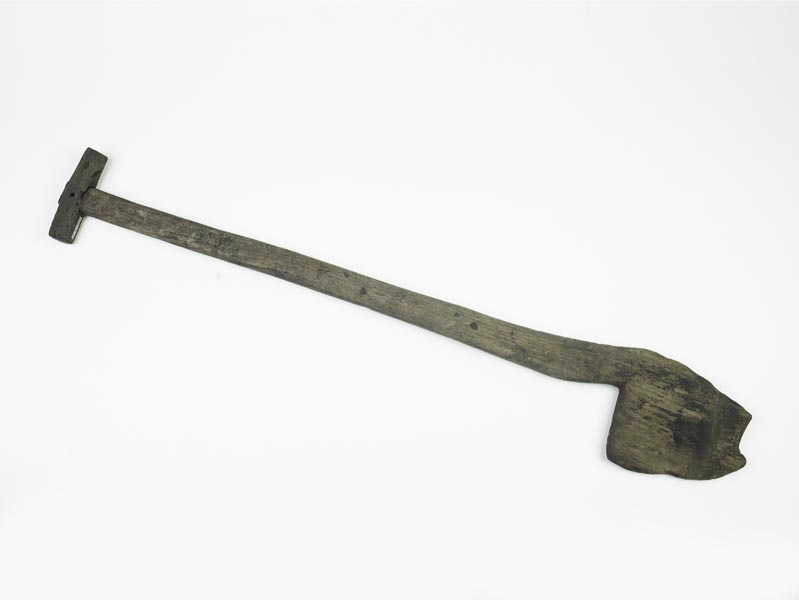
The spade to the left(Figure 2) is made of ash and has a grip of a different wood, likely walnut according to the museum’s description of the artifact. It measures L 980 mm; blade W 160 mm. The broad dating of the artifact makes it less useful than I would like, but with the lack of other good information I will take what I can get. This example still does not provide information such as the thickness of the wood, direction of the grain, method of handle attachment, or type of tool marks.
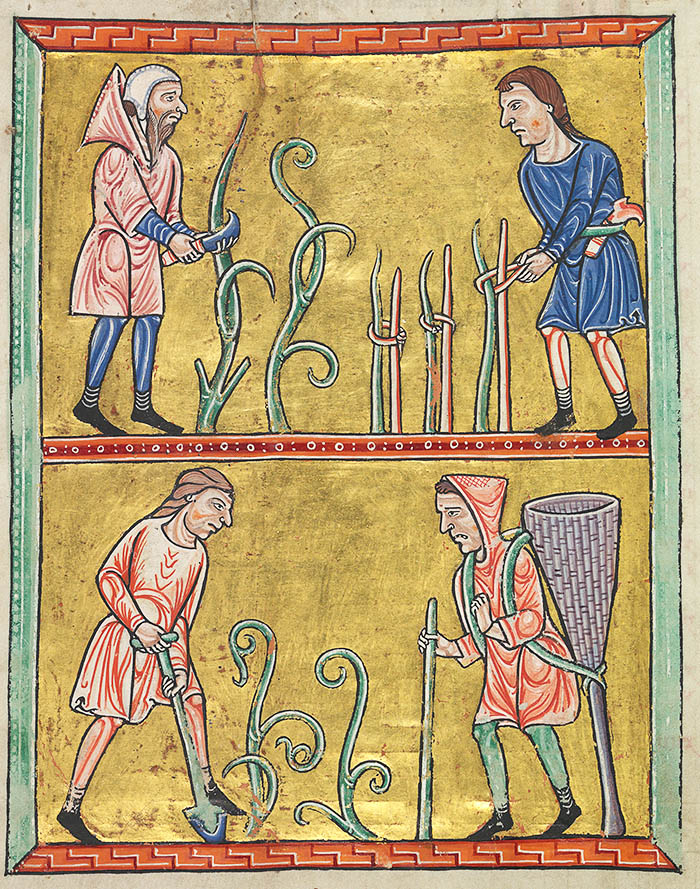
Another source of information is the illustration of shovels in period manuscripts. They appear periodically and in two general forms. There are shovels which are principally made of wood and reinforced with a metal bit (Figures 3,4), and others which have fully metal heads and wooden handles.
I made the decision to recreate the former style because of the availability of pre-fabricated shovel bits.

I do not have the facilities to work with hot metals, so I purchased a steel bit which matches the appearance of illustrated shovel bits, in particular the Psalter above (Figure 3). The beginning of my portion of this project was selecting the wood. These types of shovels are carved of one piece of wood and have an attached T handle at the top. The extant example from the London Museum is principally made of ash. This is a type of wood which is traditional for tool and weapon handles. It is quite strong and tough for its weight. Unfortunately, Ash trees in my area have been decimated by the Emerald Ash borer. I was not able to find any suitable trees myself and the local lumber yards do not sell it.
The benefits of seasoning wood was known in the middle ages, as well as the benefits of working it green.(Rettie) Wood shrinks and may warp as it dries, making joints which were once tight loose again, while wood which is worked while it is green is much softer. This shovel being made of very hard oak and a simple design, I believe that the ease of working it while green would outweigh the danger of warping for my medieval counterpart.
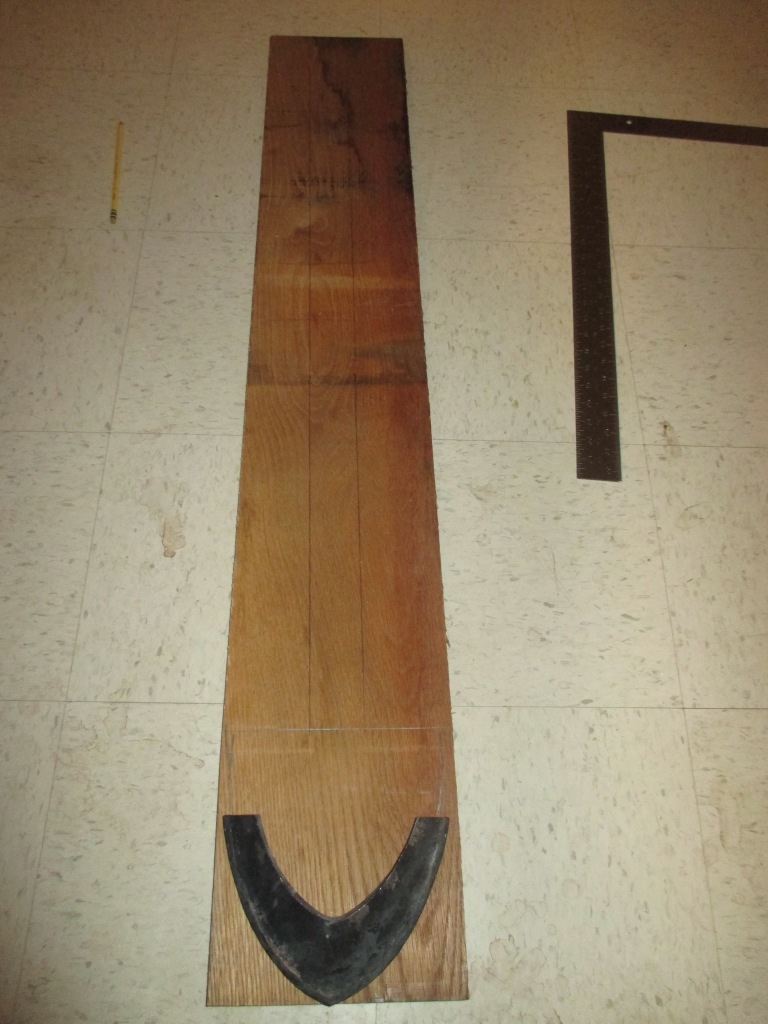
Unfortunately my shovel project called for a board approximately 20cm across. In order to get this size of board with the rings of the tree running as close to parallel to the plane of the shovel as possible, and excluding the brittle heartwood, I would need to cut down a tree over 30cm in diameter. I determined my shovel project alone was not worth the life of such a tree or the effort it would take to process the wood, and so sourced the material from a commercial lumber yard.
When selecting a piece, I looked for a board where the rings of the tree ran as close to parallel to the plane of the shovel as possible, and excluded the brittle heartwood. I went with a piece of red oak rough sawn to 32mm. This is a very strong wood, but heavier than the period but unavailable ash, and more prone to cracking.
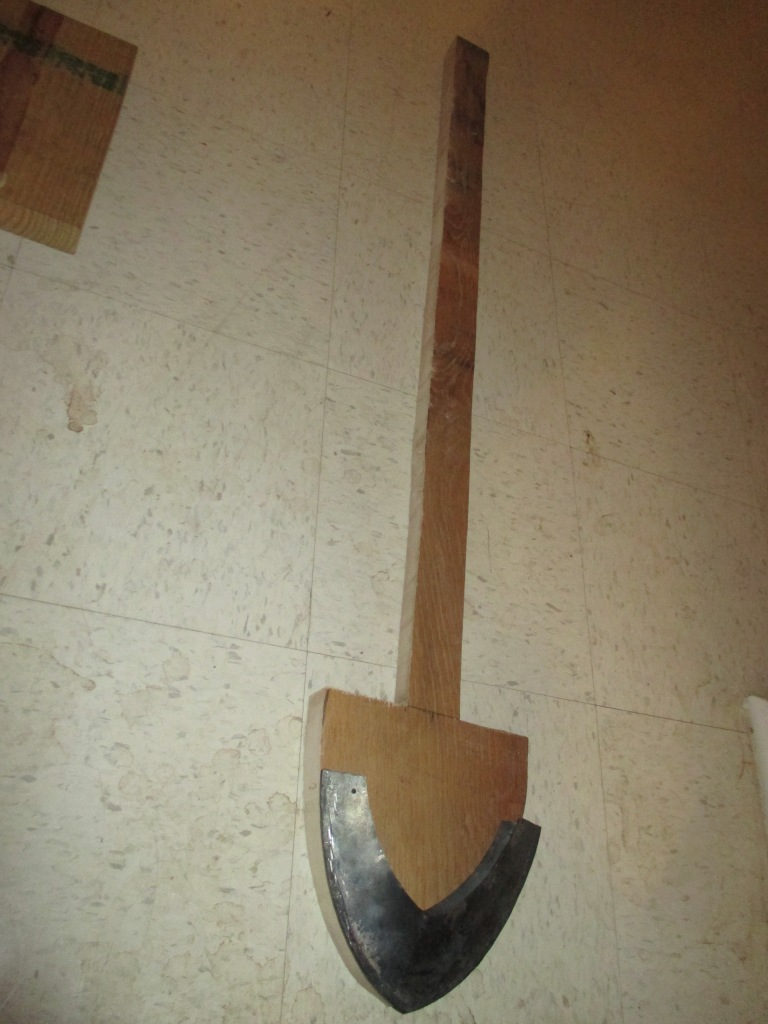
The first step of the project was to mark out the shape of the shovel.(Figure 5) I used a pencil and followed the shape of illustrated period shovels, giving it a gap between the bit and the step and a handle which comes up to my waist. The bit I purchased is 176mm across, larger than the 160mm of the London shovel but not a significant difference, especially for a tool with a slightly different design. This shape was cut out with a handheld jig saw. I justify this to myself with the fact that working the seasoned oak with hand tools to this shape would be very labor intensive, and my forebears would likely have worked it while green. Sawing the board with this mundane tool using sharp blades still took over ten minutes.

Once the profile of the shovel was cut out, I proceeded to carve the wood down to fit inside the steel bit. A significant amount of material needed to be removed, and so I chopped it away using a tool known as a side axe. This is a broad bladed axe which is often used for finishing work when squaring beams with hand tools. The handle is twisted from the plane of the axe head so the user does not injure themselves on the beam. For this project the offset handle served the same purpose.

The weakest part of this design of shovel is the joint between the handle and blade. This is also the transition point of multiple curves and the sharp angle of saw cuts. I decided to keep this “wrist” of the shovel its full thickness and greater width, while carving down the rest of the blade and handle. The London spade (Figure 2) is a somewhat different and more organic form, but also has the thickest part of the handle at this point. The blade received a distal taper toward the edge of the shovel, and then a more severe taper to fit the inside of the shovel bit. The handle was trimmed down to save on weight. This carving was done with both the side axe and a spokeshave, a tool which is a mixture of a drawknife and a plane.(Green tool, Figure 8) Once the bit fit onto the wood, I used my spoke shave to carve the roughly square cross-section of the shovel down, reducing the four corners into four new faces which each equaled the old faces, creating an octogon-section. These eight corners were then reduced, resulting in a handle which is for practical purposes round and smooth from the sharpness of my tool.

I first attempted to craft a T handle from a matching piece of oak. I used a cut in the handle and wedge to attach the handle, and when driving the wedge into the cut I cracked the original handle in half. In hindsight I am not surprised this happened, but it was a setback. The second handle was made of a piece of hickory, a much tougher wood. At this point, I was pressed for time and did not make as fine of a grip as the first one, but it is serviceable. With the grip attached, the final steps were to attach the bit and treat the wood.
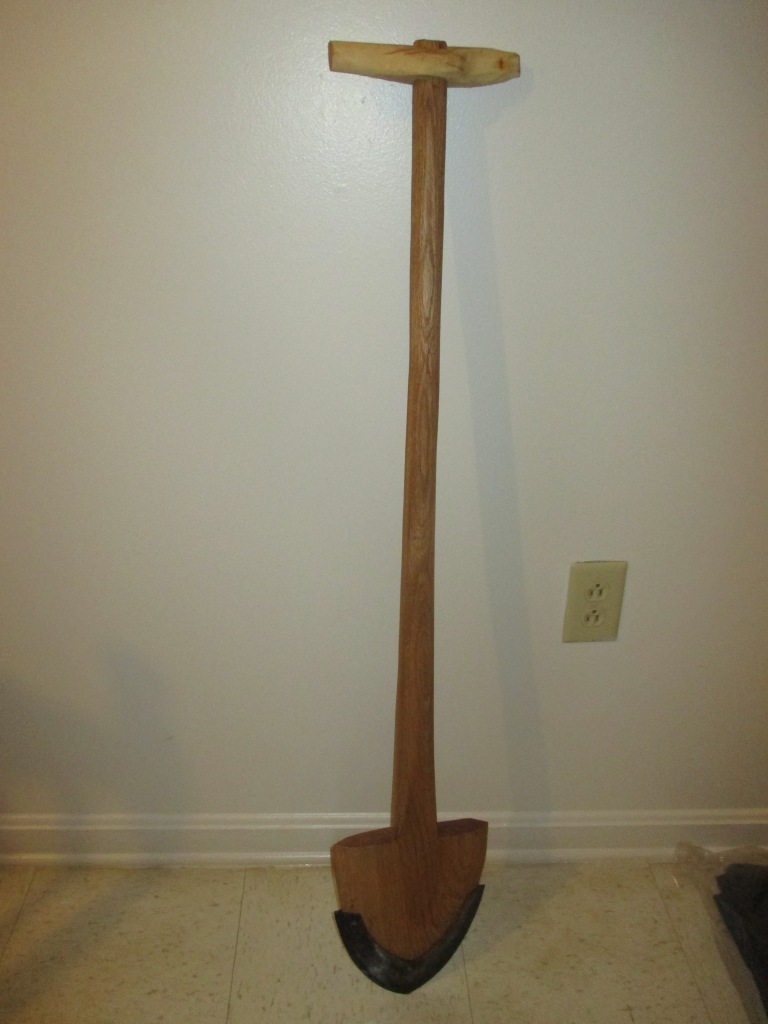
I affixed the bit using rivets I made from a piece of mild steel stock, making one head before passing it through the bit and a hole I had drilled in the wood before peening the rivet on the opposite side of the bit. Three rivets firmly secure the bit in place. Last was a thin coat of linseed oil, and the shovel was complete. While the materials and construction method were somewhat adjusted to deal with the realities of materials available in the modern world, the finished product matches the aesthetic and construction methods for an item created in the High Middle Ages.
BOAS, ADRIAN. CRUSADER ARCHAEOLOGY: the Material Culture of the Latin East. ROUTLEDGE, 1999.
Rettie, Thomas. “Did Medieval Carpenters Always Work in Green Wood?” Blood and Sawdust, https://bloodandsawdust.com/Blood_and_Sawdust/Green_Wood_versus_S easoned.html. Accessed 02 Jan. 2020, 17:20.
“Spade.” Museum of London, 24 Sept. 2013,https://collections.museumoflondon.org. uk/online/object/739844.html. Accessed 02 Jan. 2020, 1543.
I’m curious how much does your final spade weigh.
Amazing piece of experimental archeology.
LikeLike
I don’t know about amazing, but thanks! I’d guess three to four pounds. I won’t have access to it for a week or two unfortunately.
LikeLike
Sorry, I didn’t notice this comment until now. It weighs 1660g. The research involved in this project was pretty loose and no conclusions should be drawn from it.
LikeLike